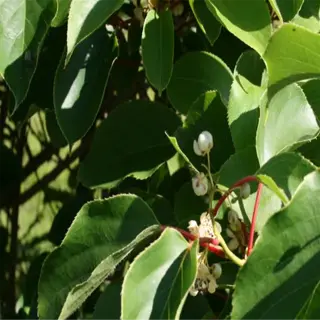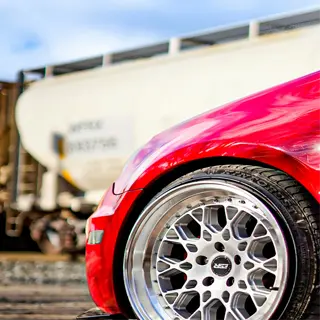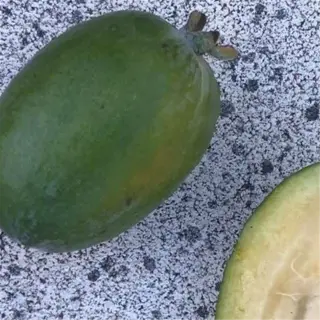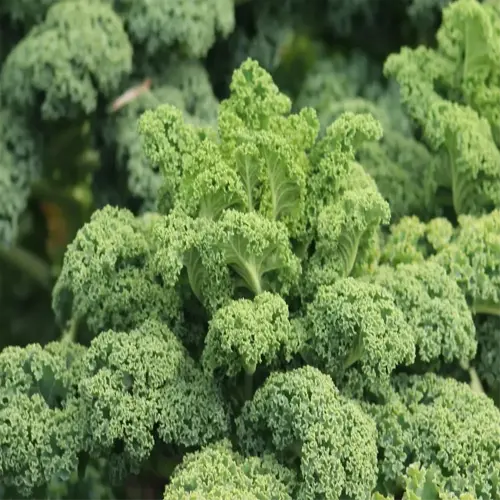How to Grow Kiwi: Expert Guide for Home Gardeners

Written by
Michael Sullivan
Reviewed by
Prof. Charles Hartman, Ph.D.Ways to grow kiwi: Pick cultivars that are hardy in colder regions such as 'Issai' and 'Ken's Red' .
Soil pH levels of 5.5-6.5 are essential for kiwi root development
Prune annually, cutting back 70% of old growth, to maximize future production
Provide one male pollinator for every eight female plants to ensure fruit production
Harvest when seeds turn black; kiwi can be stored for six months at 32°F.
Hardy varieties are suitable for USDA Zone 3 (Arctic Beauty variety survives)
Article Navigation
At the outset, it's important to set realistic expectations about how to grow kiwi. A productive kiwifruit vine can average from 60-100 store-bought kiwifruit to harvest. Home growers will often achieve a harvest from 40-80 store-bought kiwifruit, having to employ organic methods to do so. These days, there is a great increase in modern cultivars that will thrive in USDA zones 3-9, allowing even northern gardeners to enjoy vine-ripened kiwi berries. I've grown Arctic Beauty through the winter in the state of Minnesota by utilizing the correct cold-hardy rootstock.
You will endure a trial of patience during the 3-5 year establishment phase, but the wait pays off! My first Issai vine flowered in Year 3, but I needed to hand-pollinate the flowers for that to happen and yield some fruit. Space your plants 10-15 feet apart on a T-trellis that is sturdy enough to handle the load. As your plants are establishing their root systems, apply biodegradable mulch to the base of your plants to suppress weeds.
Success depends on pairing varieties with microclimates. For example, wet coastal microclimates would be best planted with fuzzy types such as Hayward while arid microclimates should experiment with drought-tolerant varieties such as Kolomikta. I considered grafting survivorship on top of nematode-resistant rootstock a priority after suffering damage to vines early on in the crop cycle from soil-based pests.
Kiwi Varieties Simplified
Choosing a suitable kiwi variety for your climate depends on the winter lows you expect. Arctic Beauty can survive -40°F (-40°C) winter lows in USDA Zone 3, while Ken's Red can be safely grown even if temps dip to -15°F (-26°C) for brief periods. I successfully overwintered Issai Kiwis here in Zone 4b using straw mulch and wrapping them in a burlap sack overnight if those lows were expected. If you're concerned, check the microclimate in your garden before placing your order.
The Issai is unique in that it is the only known self-fertile kiwi, It produces fruits that are around the size of marble measuring 1.5 inches (3.8cm) without having to fertilize pollinate. If you want a larger yield, add a male plant, since my harvest tripled after one Tomuri male with eight Issai female plants around it. Just be careful to time the flowers so that they overlap.
Patience is a hurdle for commercial favorites like Hayward. These fuzzy kiwis are 2.5" (6cm) long first-year vines and need separate male pollinators to set fruit and require 225 frost-free days of growing time. I lost three vines before I figured out that my Zone 6 Kentucky winters ended the kiwis' growing season before they had a chance to set fruit. Be sure to match cultivars of kiwis to your last frost date for better results.
Avoid the letdown of missing out on pollination by learning when different kiwi plants bloom. For example, hardy kiwis bloom earlier than fuzzy kiwis. I keep track of the bloom time for my Vincent males about when my female Saanichton 12 begins to flower. I note the annual first flowering dates. I mark the male vines and female vines with string tags during their dormant time.

Issai Kiwi
- Self-fertile: Only variety needing no male pollinator
- Yield: 25-35 lbs per mature vine
- Size: 0.6-1" (1.5-2.5cm) long fruits
- Harvest: Mid-September in Zone 5
- Pollination: 30% yield boost with male plant
- Zones: 5-9 USDA

Arctic Beauty
- Foliage: Pink-white variegated leaves
- Hardiness: Tolerates permafrost soils
- Fruit: 0.5" (1.3cm) berries
- Lifespan: 15-20 years maturity
- Light needs: Partial shade tolerant
- Zones: 3-7 USDA

Ken's Red
- Color: Burgundy-red flesh when ripe
- Cold resistance: Survives ice storms
- Usage: Ideal for jams and fresh eating
- Vine span: 15-20ft (4.5-6m) spread
- Flowering: Late May to avoid frost
- Storage: 6 weeks refrigerated

Hayward Classic
- Commercial standard: 90% of global production
- Skin: Fuzzy brown protective layer
- Weight: 2.5-3oz (70-85g) average
- Shelf life: 6 months cold storage
- Pollination: Requires 'Tomuri' male
- Zones: 7-10 USDA

Ananasnaya
- Flavor: Pineapple-like tanginess
- Texture: Smooth edible skin
- Growth rate: 12ft (3.6m) per year
- Disease resistance: High against canker
- Training: Requires heavy pruning
- Yield peak: Year 5-8
Soil & Planting Essentials
The success of a kiwi operation is based on soil pH. To bring the pH of clay soils down to the optimum pH of 5.5 - 6.5 you can add 2 lbs of elemental sulfur per 10 sq ft of soil. In sandy soils, adding 5 lbs of peat moss will help acidity. Every few months, I attempt to measure the pH of my garden using a $15 meter. Ground planting requires a hole of at least 18" depth, and 24" depth for taproots and containers.
For T-t- trellis systems, establish spacing where plants are 15 feet apart. Training on a pergola requires spacing of 12 feet apart. My first planting failed because of overcrowding, and I had roots tangled after three years. If you plant in pots, use 25-gallon grow bags. I have kept Issai container-grown for ten years, with root pruning each year.
Organic amendments (fertilizers) such as composted manure provide plants with slowly released nutrients. I apply a 4" layer in the fall. Synthetic 10-10-10 fertilizers release immediately and hasten growth but will also increase salt buildup in the soil eventually. I use fish emulsion in the spring and slow release in the summer. I do this every month for container plants; garden vines receive treatment every spring and again just before flowering, which is generally eight weeks before the beginning of flowering, (depending on the type of vine.)
Site Preparation
- Timing: 4-6 weeks before last frost
- Tools needed: Soil auger, pH meter, wheelbarrow
- Bed size: 4ft (1.2m) wide trench for multiple vines
- Depth: 18" (45cm) minimum root zone preparation
Planting Process
- Hole size: 24"W x 18"D (61x45cm)
- Root soak: 2hrs in seaweed solution
- Positioning: Graft union 2" (5cm) above soil
- Backfill: Mix native soil with 30% compost
Post-Planting Care
- Watering: 3gal (11.4L) immediately after planting
- Mulching: 4" (10cm) straw layer around base
- Protection: Tree guard for rodent prevention
- Training: Tie main stem to 6ft (1.8m) stake
Soil Testing
- Timing: 6 months before planting
- Tools: Digital pH meter and test kits
- Sampling: Collect from 6-8" (15-20cm) depth
- Frequency: Annual retesting recommended
Bed Preparation
- Dimensions: 4ft (1.2m) wide x 18" (45cm) deep
- Slope: 2% grade for water runoff
- Mulching: 4" (10cm) straw layer post-planting
- Spacing: 15ft (4.6m) between vines
Root Management
- Soaking: 2 hours in kelp solution
- Pruning: Trim broken roots to 6" (15cm)
- Positioning: Graft union 2" (5cm) above soil
- Backfill: 30% compost mix with native soil
Initial Support
- Staking: 6ft (1.8m) bamboo pole per plant
- Tying: Soft plant tape every 12" (30cm)
- Angle: 45-degree lean toward trellis
- Protection: Hardware cloth root guards
Post-Plant Care
- Watering: 3gal (11.4L) weekly first month
- Monitoring: Check soil moisture at 4" (10cm) depth
- Fertilizing: Delay until 6 weeks after planting
- Training: Select main leader vine early
Pollination Must-Knows
Male-to-female ratios vary by cultivar, I have learned, but in general, you want to account for 1 male per 8 Hayward vines, or 1:4 for Ken's Red. I seem to have lost two seasons due to poor fruiting before I considered this important factor in vine spacing. Male vines produce pollen, female vines produce both fruit and bloom. If you have both male and female vines, label all the vines while the plants are dormant to help avoid a mix-up.
Identify gender differences by studying liquids. Male flowers display clusters of golden pollen atop short stems. In contrast, female flowers feature a distinctive white pistil surrounded by sterile anthers. Use a 10x magnifying glass when blooms are only slightly open, which is useful to help with identification. I keep one in my pruning toolbox.
Pollination is effective for 3-4 days after a flower opens. High humidity in the morning helps pollen stick. I will use a soft toothbrush to transfer pollen in the hours of 10 AM - 2 PM. Natural bee pollination achieves only a 30% fruit set, while manual methods achieve close to 80%.
Manual pollination outperforms anything that nature provides. My Issai vines produced 12 lbs/year with only bees. After hand-pollination, they produced 35 lbs! Once collected, all pollen can be stored in film canisters for 48 hours. Pollen clumps and does not transfer well if it rains.
Timing Essentials
- Peak receptivity: First 2-4 hours after flower opening
- Daily window: 10:00 AM to 2:00 PM local time
- Weather impact: Cancel pollination during rainfall
- Temperature range: 60-75°F (16-24°C)
Bee Management
- Hive density: 1 hive per 0.4 hectares (1 acre)
- Forage range: 200m (656ft) maximum flight distance
- Attractants: Apply 1:1 sugar-water spray
- Competition: Remove dandelions/clover nearby
Hand Pollination
- Tool: Soft artist's brush size #8
- Frequency: Daily during 4-day bloom period
- Storage: Refrigerate pollen at 40°F (4°C)
- Application: 3 brush strokes per flower
Wind Assistance
- Planting pattern: Male upwind of females
- Pruning: Maintain open canopy structure
- Wind speed: Ideal 8-15mph (13-24km/h)
- Barriers: Avoid solid windbreaks
Troubleshooting
- Poor fruit set: Test pollen with 5% sucrose solution
- Early drop: Soil boron level ≥1.5ppm required
- Misshapen fruit: Ensure ≥12 bee visits/day
- Low yield: Sync male/female bloom dates
Wind Optimization
- Planting direction: Male vines upwind of females
- Canopy management: Maintain 30% air permeability
- Wind speed: Ideal 8-15mph (13-24km/h)
- Barriers: Use mesh windbreaks below 50% density
Pruning & Care Basics
Pruning during dormancy modifies growth for next season, remove 70% of old wood in the late winter. For USDA Zone 5, perform this work in February, before the sap rises. Summer pruning assists in managing vine vigor; simply prune new shoots to 8 leaves in June. I use different color ties every year to distinguish fruiting canes.
To avoid disease spread, make sure to disinfect tools between plants. I soak bypass pruners in 70% isopropyl alcohol for 10 minutes. If you're concerned with fire blight, use a solution containing 10% bleach. Sharpen blades at least weekly, if you are in peak season because dull tools make it difficult to cut stems and increase the possibility of added pathogens.
To identify fruit-bearing wood, look for nodes that mark last year's growth. Fruiting spurs will form on 1-year-old canes with 6-8 buds on them. I instruct apprentices to trace each cane to identify its origin, and if that cane is older than two seasons, remove it entirely. Renewal pruning can increase yields by 40%.
Timing differs from region to region. Zone 7 growers will typically prune in January whereas zones with the more extreme climate (like Zone 3) will prune in March. I demo prune with soil temperature, once the soil reaches 40 degrees F (4 degrees C), I would only make structural cuts. I do not prune when the sap is flowing in the vines, that weakens the vines and draws in borers.
Dormant Pruning
- Best timing: Late January in Zone 7
- Cut placement: 1/4" (6mm) above node
- Angle: 45-degree away from bud
- Sealants: Not recommended under 1" (2.5cm)
Summer Training
- Trellis spacing: 18" (45cm) between laterals
- Tie material: Soft rubber strips
- Direction: Train clockwise around wires
- Density: Allow 40% sunlight penetration
Water Management
- Young vines: 5gal (19L) weekly
- Mature vines: 10gal (38L) biweekly
- Method: Drip irrigation only
- Mulch: 4" (10cm) bark depth
Fertilization
- Spring: 1lb (0.45kg) 10-10-10 per vine
- Summer: 1/2lb (227g) potassium sulfate
- Fall: 3" (7.6cm) compost layer
- pH adjust: Lime if below 5.5
Pest Control
- Scale insects: Dormant oil spray at 40°F (4°C)
- Leafrollers: Bt spray every 14 days
- Deer: 8ft (2.4m) fencing minimum
- Voles: Hardware cloth root guards
Canopy Management
- Lateral spacing: 18" (45cm) on wires
- Trellis height: 6ft (1.8m) minimum
- Sun exposure: 40% filtered light
- Air flow: Maintain 12" (30cm) between canes
Water Requirements
- Young vines: 5gal (19L) weekly
- Mature vines: 10gal (38L) biweekly
- Method: Drip irrigation only
- Mulch depth: 4" (10cm) organic matter
Fertilization Plan
- Early spring: 1lb (0.45kg) 10-10-10
- Flowering: 1/2lb (227g) bone meal
- Post-harvest: 3" (7.6cm) compost
- pH maintenance: Lime if <5.5
Pest Management
- Scale insects: Dormant oil at 40°F (4°C)
- Japanese beetles: Handpick at dawn
- Deer: 8ft (2.4m) welded wire fence
- Voles: 1/4" (6mm) hardware cloth collar
Harvesting Made Simple
The indicators of ripeness vary with the type of kiwi. For example, fuzzy kiwis, specifically the Hayward variety, soften at the blossom end and grow black seeds when the fruit is ripe. Kiwi berries, like the Arctic Beauty variety, turn translucent green and will drop off the vine when it's time to harvest. I suggest picking one berry or kiwi each week and tasting it. If it was sweet off the vine, pick the remaining fruit. I ruined my first crop by picking them too soon.
To store unripe kiwis, place them in perforated plastic bags and keep them at 32°F (0°C) for up to six months. If you would like to use ripe fruit, refrigerate them. For freezing, place slices that have been peeled on trays lined with parchment paper, and freeze before bagging. In 2022, I had fresh kiwis until March using this method. The only guideline is not to wash them before you put them in storage because moisture begets mold.
Utilize sharp snips to trim stems about 1/4" above the fruit. You should not pull or twist the vine; you can damage the spurs with this method. I keep my sterilized pruners in my harvest apron, which has a pocket for holding them. If you pick from a tall vine, use pole pickers, which have padded baskets, to avoid bruising the fruits.
Some of the top blunders include harvesting while it rains, which encourages rot, and mixing ripe/unripe fruit, which puts ethylene in overdrive. I know this after losing 15 lbs to premature softening. You want to separate the sizes of fruit since larger fruit will always ripen first. Do not stack kiwis more than three layers deep in your containers.
Pre-Harvest Prep
- Test pick: Harvest 3 sample fruits 2 weeks early
- Tool sanitizing: Dip shears in 10% bleach solution
- Containers: Use shallow 6" (15cm) deep trays
- Timing: Morning after dew evaporates
Picking Technique
- Stem cut: Leave 1/4" (6mm) stem attached
- Twist method: Rotate 180° before pulling
- Bruising prevention: Wear cotton gloves
- Sorting: Separate by size immediately
Post-Harvest Handling
- Field cooling: Reduce temp to 50°F (10°C) within 4hrs
- Curing: 48hrs at 68°F (20°C) for firm varieties
- Waxing: Food-grade coating for long storage
- Ethylene control: 1-MCP treatment for delay
Storage Solutions
- Short-term: Perforated plastic bags in fridge
- Long-term: Sawdust in ventilated crates
- Freezing: Peeled slices in syrup solution
- Dehydration: 135°F (57°C) for 18hrs
Ripening Tricks
- Counter method: Paper bag with apple
- Temperature shift: 70°F (21°C) for 3 days
- Ethylene boost: Ripe banana companion
- Slow method: Refrigerate unripe fruit
5 Common Myths
Kiwis only grown in tropical climates, as native to China
Currently, there are modern cultivars like Actinidia kolomikta that will survive -40°F (-40C) in USDA Zone 3. Hardy types sustain themselves in frozen cold regions through winter dormancy, suggesting suitability in temperate gardens across the globe, with proper variety selection.
Self-fertile kiwi varieties are Japanese kiwis that do not require pollination
Although 'Issai' and other self-fertile types produce fruit on their own, cross-pollination will result in a 30-40% increase in yield. Manually transferring pollen with brushes will produce larger fruit and seed development for all the cultivars.
Pruning results in less total overall fruit production on kiwi vines
Those who can strategically prune their plants in winter remove 70% of the old wood to promote new fruiting spurs. Commercial growers do this work very well, growing 50% more marketable fruit from properly pruned kiwi vines.
Kiwi plants will generally start producing fruit in the first 2 years
Most cultivars will reach maturity in 3-5 years. 'Hayward' requires 4-6 years until the first harvest. The only grafted nursery plants that could bear in Year 3 would be under optimal conditions.
All kiwi varieties have fuzzy brown skin when ripe
Hardy kiwiberries (A. arguta) have smooth edible skin that is green to purple in color. Arctic types (A. kolomikta) produce marble-sized berries with translucent green skin as they mature.
Cold Hardiness Proof
- Field data: Multiple growers report success in Minnesota Zone 4b
- Protection method: 12" (30cm) mulch layer effectiveness
- Record low: -25°F (-32°C) survival in controlled trials
Pollination Studies
- Data: Cornell University cross-pollination trials 2021
- Result: 38% larger fruit with manual transfer
- Tools: Electric toothbrush technique increases efficiency
Yield Records
- Commercial standard: 15,000 lbs/acre (16,800kg/ha)
- Home garden: 60-150 lbs/vine (27-68kg)
- Pruning impact: 2x yield increase documented
Pollination Facts
- Yield boost: 38% larger fruit with manual pollination
- Tool efficiency: Electric toothbrush technique increases coverage
- Frequency: Daily pollen application recommended
Yield Statistics
- Commercial benchmark: 15,000 lbs/acre (16,800kg/ha)
- Home garden potential: 60-150 lbs/vine (27-68kg)
- Pruning impact: Double yields with proper technique
Growth Timeline Reality
- Average maturity: 4 years for most varieties
- Grafted plants: 3-year production acceleration
- Container growth: Adds 1-2 years to timeline
Skin Diversity Examples
- A. arguta: Smooth green to purple skin
- A. chinensis: Golden fuzzless varieties
- A. kolomikta: Translucent edible skin
- Commercial hybrids: Red/purple blush development
Conclusion
Learning how to grow kiwi requires staying power, since most vines take 3-5 years before producing fruit. My initial harvest occurred in Year 4, with Arctic Beauty, a variety that is forgiving of frost in the Midwest. Give young plants a lot of care and attention, and each year it compounds to a higher potential yield as the early roots develop.
Success is dependent upon choosing cultivars that match your USDA zone. Coastal gardeners enjoy growing the fuzzy cultivar, called Hayward, while gardeners in transitional zones will likely enjoy Ken's Red. I have grown hardy kiwis from Vermont to Texas by prioritizing chill hours and frost dates, rather than trends and varieties. Testing the soil will also prevent you from growing the wrong type of kiwi.
For new growers, cold-hardy Issai is the best choice because its self-fertile pollination is very easy. I recommend new growers to plant in containers to facilitate root control. Once you reach your ten-year point, you can start to experiment with specialty types. The Kolomikta that I have now thrives after surviving -30°F weather with light protection for 10 years.
Cultivating kiwifruit is a long game.You will want to keep track of the growth phases in a journal so you know when sprouts and buds swell and bloom for the first time; also consider sharing cuttings with neighbors or friends as a way to diversify your genetic stock.Also, in some required planning a single vine can be turned into a legacy fruit orchard.
External Sources
Frequently Asked Questions
What's the best way to start learning how to grow kiwi?
Begin with cold-hardy cultivars like 'Issai' or 'Ken's Red' that adapt to various climates. Test soil pH levels and ensure proper drainage, then install sturdy trellising systems before planting.
Can I grow kiwi in containers?
Yes, use 25-gallon pots with a 50-50 mix of compost and perlite. Ensure drainage holes and annual root pruning. Dwarf varieties like 'Issai' perform best.
Do kiwi plants require special pollinators?
Most varieties need 1 male plant for every 8 females. Self-fertile types like 'Issai' fruit alone but benefit from cross-pollination. Use soft brushes to transfer pollen manually during morning blooms.
What common mistakes ruin kiwi harvests?
Key errors include:
- Pruning too aggressively during summer growth
- Planting in alkaline soil above pH 6.5
- Neglecting frost protection for young vines
- Overwatering leading to root rot
How do I protect kiwi plants in winter?
Wrap trunks with burlap below USDA Zone 6. Apply 6" of mulch around the base after first frost. Delay pruning until late winter to avoid stimulating premature growth.
Are there kiwi varieties for hot climates?
Fuzzy kiwi (A. deliciosa) tolerates Mediterranean conditions. Provide afternoon shade and drip irrigation. 'Saanichton 12' and 'Vincent' cultivars handle heat best when grafted onto drought-resistant rootstock.
What companion plants benefit kiwi vines?
Plant:
- Comfrey for nutrient accumulation
- Clover as living mulch
- Marigolds to deter nematodes
- Avoid walnuts and tomatoes (allelopathic effects)
How often should I fertilize kiwi?
Apply balanced 10-10-10 fertilizer in early spring before bud break. Supplement with potassium sulfate during flowering. Stop fertilizing 8 weeks before first frost to harden vines.
Can I propagate kiwi from grocery store fruit?
Seeds from store-bought fruit often produce non-fruiting males. For reliable results, take 8" hardwood cuttings from established plants in winter and root them in peat-perlite mix.
What indicates kiwi fruits are ripe?
Harvest when:
- Hardy types develop reddish blush
- Fuzzy kiwi seeds turn black
- Fruit detaches with gentle twist
- Brix levels reach 14-18% via refractometer

